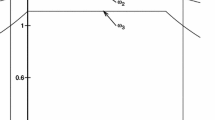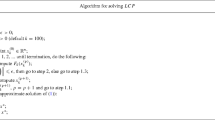Abstract
In an earlier paper, the author has given some necessary and sufficient conditions for the convergence of iterative methods for solving the linear complementarity problem. These conditions may be viewed as global in the sense that they apply to the methods regardless of the constant vector in the linear complementarity problem. More precisely, the conditions characterize a certain class of matrices for which the iterative methods will converge, in a certain sense, to a solution of the linear complementarity problem for all constant vectors. In this paper, we improve on our previous results and establish necessary and sufficient conditions for the convergence of iterative methods for solving each individual linear complementarity problem with a fixed constant vector. Unlike the earlier paper, our present analysis applies only to the symmetric linear complementarity problem. Various applications to a strictly convex quadratic program are also given.
Similar content being viewed by others
References
Pang, J. S.,Necessary and Sufficient Conditions for the Convergence of Iterative Methods for the Linear Complementarity Problem, Journal of Optimization Theory and Applications, Vol. 42, pp. 1–18, 1984.
Pang, J. S.,On the Convergence of a Basic Iterative Method for the Implicit Complementarity Problem, Journal of Optimization Theory and Applications, Vol. 37, pp. 149–162, 1982.
Murty, K. G.,On the Number of Solutions to the Complementarity Problem and Spanning Properties of Complementarity Cones, Linear Algebra and Its Applications, Vol. 5, pp. 65–108, 1972.
Ostrowski, A. M.,Solution of Equations and Systems of Equations, 2nd Edition, Academic Press, New York, New York, 1966.
Cottle, R. W., andDantzig, G. B.,Complementary Pivot Theory of Mathematical Programming, Linear Algebra and Its Applications, Vol. 1, 1968, pp. 103–125.
Eaves, B. C.,On Quadratic Programming, Management Science, Vol. 17, pp. 698–711, 1971.
Mangasarian, O. L.,Solution of Symmetric Linear Complementarity Problems by Iterative Methods, Journal of Optimization Theory and Applications, Vol. 22, pp. 465–485, 1977.
Rockafellar, R. T.,Convex Analysis, Princeton University Press, Princeton, New Jersey, 1972.
Eaves, B. C.,The Linear Complementarity Problem, Management Science, Vol. 17, pp. 68–75, 1971.
Mangasarian, O. L.,Sparsity-Preserving SOR Algorithms for Separable Quadratic and Linear Programming Problems, Computers and Operations Research (to appear).
Cottle, R. W., andPang, J. S.,On the Convergence of a Block Successive Overrelaxation Method for a Class of Linear Complementarity Problems, Mathematical Programming Study, Vol. 17, pp. 126–138, 1982.
Han, S. P., andMangasarian, O. L.,A Dual Differentiable Exact Penalty Function, Mathematical Programming, Vol. 25, pp. 293–306, 1983.
Cottle, R. W., andDuvall, S. G.,A Lagrangian Relaxation Algorithm for the Constrained Matrix Problem, Stanford University, Department of Operations Research, Systems Optimization Laboratory, Technical Report No. SOL-82-10, 1982.
Ha, C. D.,An Algorithm for Structured, Large-Scale Quadratic Programming Problems, University of Wisconsin-Madison, Mathematics Research Center, Technical Report No. 2276, 1981.
Rockafellar, R. T.,Augmented Lagrangians and Applications of the Proximal Point Algorithm in Convex Programming, Mathematics of Operations Research, Vol. 1, pp. 97–116, 1976.
Ha, C. D.,Decomposition Methods for Structured Convex Programming, University of Wisconsin-Madison, Department of Industrial Engineering, PhD Dissertation, 1980.
Robinson, S. M.,Some Continuity Properties of Polyhedral Multifunctions, Mathematical Programming Study, Vol. 14, pp. 206–214, 1981.
Ortega, J. M., andRheinboldt, W. C.,Iterative Solution of Nonlinear Equations in Several Variables, Academic Press, New York, New York, 1970.
Dennis, J. E., Jr., andMoré, J. J.,Quasi-Newton Methods, Motivation and Theory, SIAM Review, Vol. 19, pp. 46–89, 1977.
Author information
Authors and Affiliations
Additional information
Communicated by O. L. Mangasarian
The author gratefully acknowledges several stimulating conversations with Professor O. Mangasarian on the subject of this paper. He is also grateful to a referee, who has suggested Lemma 2.2 and the present (stronger) version of Theorem 2.1 as well as several other constructive comments.
This research was based on work supported by the National Science Foundation under Grant No. ECS-81-14571, sponsored by the United States Army under Contract No. DAAG29-80-C-0041, and was completed while the author was visiting the Mathematics Research Center at the University of Wisconsin, Madison, Wisconsin.
Rights and permissions
About this article
Cite this article
Pang, J.S. More results on the convergence of iterative methods for the symmetric linear complementarity problem. J Optim Theory Appl 49, 107–134 (1986). https://doi.org/10.1007/BF00939250
Issue Date:
DOI: https://doi.org/10.1007/BF00939250




